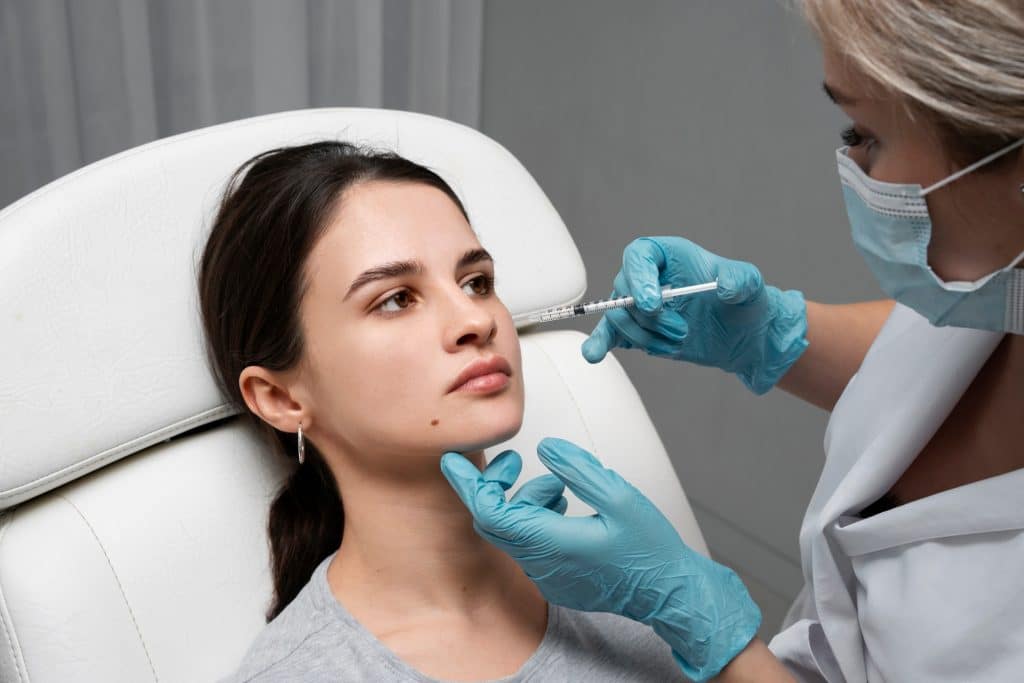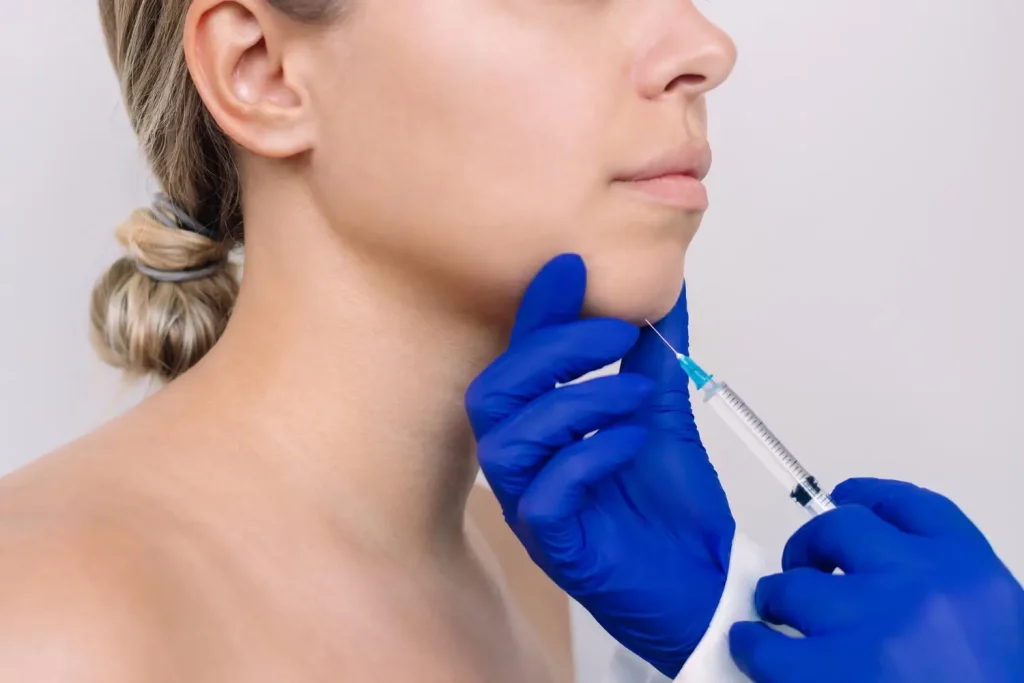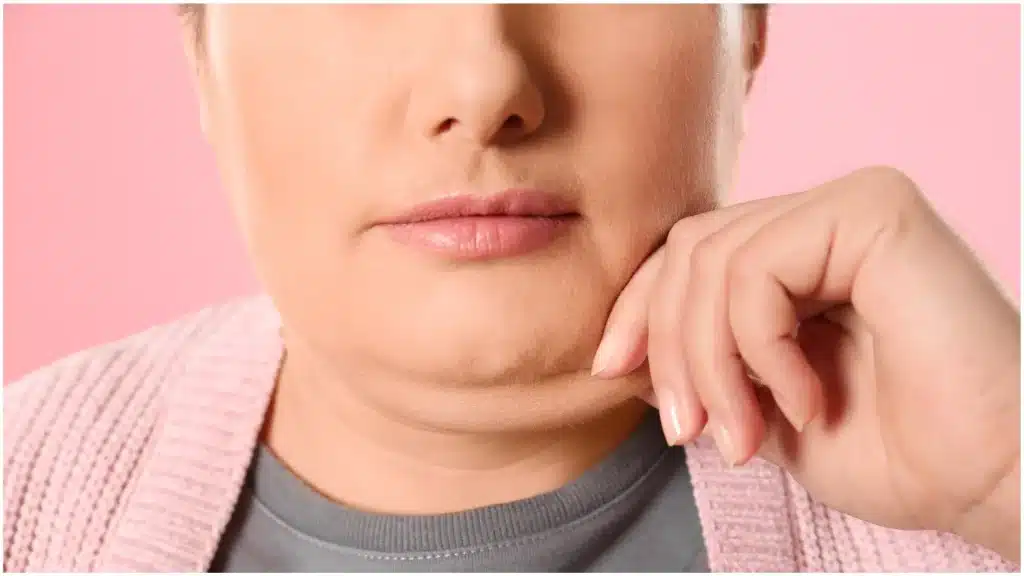In recent years, more people have desired a sculpted facial profile. The American Academy of Facial Plastic and Reconstructive Surgery (AAFPRS) reports that in 2021, they saw a 40% surge in facial plastic surgeries in the United States. However, surgery isn’t for everyone, and the potential risks associated with these invasive treatments can put off many from pursuing this option.
Dysport is an injectable neurotoxin that offers a minimally invasive and precise solution for achieving a sculpted look. It can slim and sharpen the jawline to create a more defined and balanced appearance by targeting and temporarily relaxing the masseter muscle.
This article will explore how Dysport sculpts the jawline through masseter muscle relaxation, ultimately enhancing facial definition. If you want to read more about using Dysport on the forehead area, we’ve covered that topic too.
Key Takeaways
- Dysport injections can be used for masseter muscle sculpting to achieve facial contouring and harmony.
- Understanding the anatomy of the masseter muscle is crucial for successful Dysport treatment.
- Proper patient selection, injection techniques, and dosing considerations are essential for achieving optimal outcomes and minimizing potential complications.
About: Medical Spa RX provides medical practices with premium products at the best prices. If you’re looking to order Dysport online for your practice, the sales representatives at Medical Spa RX can give you guidance.
The Anatomy of the Masseter Muscle

The masseter is a paired, powerful muscle on either side of the jaw. Often described as “quadrangular” due to its four-sided shape, it’s the most prominent muscle involved in chewing. It is a strong, thick, rectangular muscle that originates from the zygomatic arch and extends to the mandibular angle.
The masseter muscle’s primary functions include the elevation and protrusion of the mandible, which is crucial for biting and grinding food. Here’s a closer look at its two main parts:
- Superficial Layer: This part originates from the zygomatic arch, the bony ridge beneath a person’s cheekbone.
- Deep Layer: This layer arises from the lower portion of the zygomatic arch and the maxilla, the upper jawbone.
Due to its size and strength, the masseter muscle significantly impacts facial aesthetics. A well-defined masseter contributes to a chiseled jawline, particularly noticeable from the side profile. However, the masseter’s hypertrophy, or enlargement, can create a square jawline and a broader face. This effect can concern females as it can masculinize their appearance.
Importance of Masseter Muscle Sculpting
Sculpting the masseter muscle has become an essential aesthetic procedure for those seeking a more refined jawline. Techniques such as botulinum toxin injections can reduce the muscle’s bulk, soften the jaw’s appearance, and contribute to facial harmony.
Additionally, masseter sculpting can alleviate symptoms associated with bruxism, such as teeth grinding and clenching, improving the quality of life. This treatment could also decrease stress on the maxillary and mandibular bones, preventing tooth loss and progressive bone resorption.
Indications for Dysport Treatment

Dysport, a brand name for abobotulinumtoxinA, is a neurotoxin similar to Botox that can have therapeutic and aesthetic purposes. Though it’s widely known as a treatment for wrinkles by injecting Dysport in the forehead or other facial areas, it can also reshape a person’s contours and treat masseter muscle hypertrophy.
Masseter hypertrophy refers to an enlargement of the masseter muscle, the primary muscle responsible for chewing. This enlargement can be unilateral (affecting one side) or bilateral (affecting both sides). While a certain degree of masseter development is standard, hypertrophy significantly increases size, altering facial aesthetics.
Signs and Symptoms of Masseter Hypertrophy
The signs and symptoms of masseter hypertrophy include a visible swelling in the angular mandibular region, changes in facial contour, and well-localized pain. Patients may also experience limitations in opening their mouths, swollen cheeks, and tension in the area of the hypertrophied muscle. While it is often asymptomatic, the chief complaint from patients is typically related to aesthetics rather than pain.
Patient Dissatisfaction and Aesthetic Concerns
Masseter hypertrophy can lead to significant patient dissatisfaction with their facial appearance. The altered facial lines and the negative cosmetic impact can lead to psychological issues, such as a lack of self-confidence and body dysmorphic disorder (BDD).
Patients often seek treatments like Dysport for masseter muscles to achieve a more harmonious facial appearance and to alleviate the distress associated with the perceived imperfection.
Injection Techniques for Masseter Muscle Sculpting
A licensed doctor or specialist should thoroughly inform their patients about the procedure, potential side effects, and aftercare instructions before administering Dysport injections for masseter muscle sculpting. Due to subtle differences in product dosage compared to other botulinum toxins, patients must also select a provider with extensive experience with Dysport.
Some of the general guidelines patients can follow to get ready for the procedure are the following:
- Avoid blood-thinning medications, smoking, and alcohol before the procedure to minimize the risk of bleeding and bruising in the injection sites.
- Attend the appointment with a clean face without makeup to reduce the risk of infection at the target areas.
Identifying Injection Sites
An experienced specialist typically determines Dysport’s masseter muscle injection sites by palpating the muscle while the patient clenches their teeth. Once the specialist identifies the thickest part of the muscle, they will mark this as the injection site for the procedure.
When using Dysport in the masseter muscle, a qualified healthcare professional uses three to five points for the injection. These points allow and ensure even product distribution to achieve the patient’s desired sculpting effect.
Injection Depth and Angle
The injection depth and angle are critical to the success of Dysport treatment. Injections are generally intramuscular, requiring precise placement into the masseter muscle to avoid affecting surrounding muscles and tissues.
The administering doctor should adjust the injection depth based on the masseter muscle’s thickness. The angle should be perpendicular to the skin surface to ensure product diffusion within the target muscle.
Providers must be cautious to avoid injecting too superficially, which could lead to product spread and unintended muscle relaxation.
Expected Outcomes and Patient Selection Criteria

Dysport works by relaxing the masseter muscle, leading to a gradual reduction in its size. This treatment translates to:
- Slimmer Jawline: The square appearance of the jaw should soften, creating a more sculpted and defined facial profile.
- Improved Facial Symmetry: Dysport can help achieve a more balanced jawline in cases of unilateral hypertrophy.
- Potential TMJ Pain Relief: Dysport might alleviate discomfort associated with bruxism and TMJ dysfunction by reducing muscle tension.
However, results can vary based on individual anatomy and response to the neurotoxin. Most patients notice an improvement within 2-3 days post-treatment, with the full effect typically visible after two weeks. Doctors must help their patients understand that while Dysport can significantly improve the jawline’s appearance, it does not entirely reshape the bone structure underlying the muscle.
A detailed consultation helps patients understand what Dysport can and cannot achieve, leading to higher satisfaction with the treatment results.
Dosing Considerations and Potential Complications
The appropriate dosage of Dysport for masseter muscle treatment varies based on individual patient factors such as muscle mass, severity of hypertrophy, and desired aesthetic outcome. Generally, the total dose for adult spasticity, which can be a reference for masseter treatment, should not exceed 1500 Units.
Healthcare professionals must carefully calculate the dosage, considering the patient’s previous responses to botulinum toxin treatments and any adverse reactions. Correct dilution and volume is crucial to ensure the desired effect while minimizing the risk of Dysport spreading to adjacent muscles.
Managing Patient Discomfort During Injections
Healthcare professionals can employ several strategies to manage discomfort during Dysport injections. These strategies include using a fine needle, proper injection technique, and applying a topical anesthetic or ice to the targeted areas.
Patients must feel relaxed during the procedure, as tense muscles can increase discomfort. Professionals can inject the product quickly but carefully to avoid over-manipulating the injection site.
Potential Side Effects and Complications
Dysport injections for masseter sculpting carry potential side effects and complications as with any medical procedure. These effects are usually mild and temporary, but it’s essential to be aware of them:
- Injection Site Reactions: Temporary redness, swelling, bruising, or tenderness at the injection points are common and typically resolve within a few days.
- Facial Asymmetry: Uneven injection or muscle response can lead to temporary facial asymmetry. The administering doctor can correct facial asymmetry by adjusting the dosage in follow-up sessions.
- Headache: Mild headaches can occur after the procedure but usually subside independently.
- Pain: In rare cases, some patients might experience increased jaw pain or discomfort following the injections.
Conclusion
Dysport injections offer a targeted and practical approach to achieving a slimmer jawline and a more sculpted lower face. A thorough understanding of the masseter muscle anatomy, carefully selecting suitable candidates, and proper injection techniques by qualified professionals are crucial for success.
Dysport can be a valuable tool for those seeking aesthetic improvements in the lower face if they carefully consider dosage and potential side effects.
FAQs
1. What does Dysport do for your face?
Dysport is a neuromodulator injection that temporarily reduces muscle activity to smooth fine lines and wrinkles, leading to a more youthful facial appearance. Doctors can also use it off-label to achieve jawline contouring and sculpting.
2. Can I get Dysport treatment if I’m breastfeeding?
It is generally not recommended to receive Dysport treatments while breastfeeding due to the lack of studies on its safety during this period.
3. Is Dysport safe?
Like any medical procedure, Dysport can have side effects and is not suitable for everyone. However, it is FDA-approved and safe for administration as long as a qualified healthcare professional performs the treatment.
References
Solutions TKI. American Academy of Facial Plastic and Reconstructive Surgery. American Academy of Facial Plastic and Reconstructive Surgery. https://www.aafprs.org/Media/Press_Releases/2021%20Survey%20Results.aspx
Almukhtar R, Fabi SG. The masseter Muscle and its Role in facial contouring, aging, and quality of Life: a literature review. Plastic and Reconstructive Surgery. 2019;143(1):39e-48e. doi:10.1097/prs.0000000000005083



















